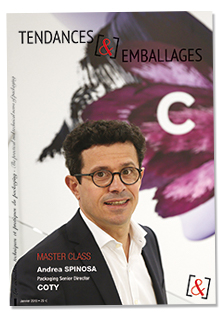
 is a quarterly review which summarises current events and technical information about printed packaging.
is a quarterly review which summarises current events and technical information about printed packaging.
From the initial idea to the production of the packaging, you will find useful information which is essential for professionals in this industry (such as buyers, decision-makers, buyers, packaging manufacturers and suppliers of raw materials).
Tendances et Emballages « Detector of trends » your partner for your development.
January 2019
-----------------------------------------------------------------------------------------------------------------------------
OPINION
David Mingeon, deputy chief executive officer of Havas Paris
It did not take long for David Mingeon to remember this box, a metal box in which his grandmother held his sweet treasures. The madeleine of Proust “pretty magical” in the centre of the table and the ideas he now agitates with insight. A meeting with the Deputy Chief Executive Officer of Havas Paris, a precise and precious point of view about our company.
It all starts with a crush. In this case, the filter goes through a teacher that David appreciated. Fast-forward to Bac (+2). The young graduate goes off on a tangent and embarks on communication. A few years later, after his career, from trainee to head of advertising, he is one of the creative heads at Havas Paris. If he does not like to talk about himself, David Mingeon has a lot of ideas about us as consumers. Through the observatory Shopper Observer initiated by Havas Paris and himself, he gives us the five pillars of consumer evolution. The future is now:
From the route of the purchase to the course of life.
“With the advent of digitalisation, the notion of a physical journey, that is, going to a store, is obsolete”, says David Mingeon. A majority of French people (59%) have less and less desire to spend time shopping. Doing the shop is experienced as a chore for 32% of French respondents. CQFD: “Initially, the packaging is there to challenge, to seize a product within a radius. However, the consumer no longer comes to the store, there is a 10% decline in recent years in favour of a 15% increase in digital shopping. Obviously, packaging must have another feature.”
The conversational age
What about this new feature? David says, “The consumer does not need to see the product anymore. What is interesting to observe, from some players in online commerce, is the way they made packaging a strong element of conviction, a magical side. Packaging is no longer an element of information but of the experience”. Packaging perfumed and above all connected able to interact with the customer. Exit tests and experiments, the consumer speaks to objects, control it “in a natural language, or simply by ordering his favourite shopping list!”
Customer care for healthy manufacturing
According to the Shopper Observatory, 86% of French people feel that everyday products are dangerous for their health. A naturally strong concern for all food products, but stronger with all non-food. Fear for oneself, one’s children and the environment. A major issue for David Mingeon: “Every time we buy a product, we ask ourselves two questions: does it hurt us? Is it harmful to the planet?” As a result, there is a strong trend towards “Package Free”, which offers a packaging-free, waste-free offering or in Japan “Seven”, who, in association with Colas, installs a photovoltaic coating in their supermarkets to supply the store and vehicles with renewable energy.
Big data, safe data and sale data
Whether hidden or not, the couple Big Data and Privacy, highlights a paradox that is not exclusively French. “How far are we willing to lose of our private life and in exchange of what? Are we going to whisper in our own homes for fear of being listened to? Are we ready to have an RFID chip implanted under our skin to pay for our purchases? Worrying question or not, the observatory of Havas Paris points out that 7% of French people say they are ready to have an RFID chip in their bodies to make their lives easier.
The new trendy discount
Last but not least, the new trendy discount. As an example, David Mingeon cites the case of Citizen M Hotels. A large lobby, but small rooms equipped and connected on the large scale. The connected travellers are invited to share the best in design and comfort. On the menu: large relaxation areas and co-working spaces, all in a trendy atmosphere where art and design mix. Here, all the rooms are formatted in the same way, but all the furniture and lighting are designed by contemporary design references (the lighting from George Nelson, Eames Brothers seating and Antonio Citterio sofas ...).
Through this ambitious study, David Mingeon offers us a glimpse of the future between the ethical issues, an approach both ecological and virtualised. Welcome to the era of smart phygital!

